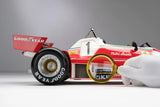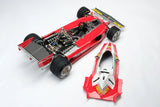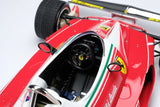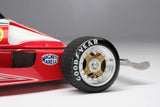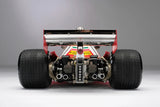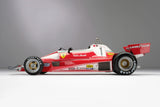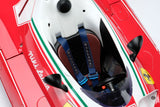The second iteration of the hugely successful 312 T chassis, the 312 T2 was Scuderia Ferrari’s entry for the majority of the 1976 FIA Formula 1 World Championship season. Piloted by reigning World Champion Niki Lauda, Swiss racer Clay Regazzoni and for a single race at the Italian Grand Prix, Argentine Carlos Reutemann, the 312 T2 played a large role in one of the most legendary duels in Formula 1 history: Lauda versus James Hunt.
Due to changes to the aerodynamic rules for the 1976 season, the T2 was practically a brand-new car. Periscope air intakes were banned, limiting the overall height of the car. This meant that new ducts had to be designed, running from the front part of the cockpit to channel air to the two rows of carburettors over the cylinder heads. Other lower ducts sent cooling air to the radiators. The previous year’s suspension was recycled, but the car was now lighter thanks to a new chassis structure, despite a 42mm longer wheelbase.
The 312 T2 replaced its predecessor after three races of the season, all of which Ferrari had won, at the 1976 Spanish Grand Prix. Its debut race saw Lauda beaten by title rival James Hunt, though Hunt was then disqualified in post-race scrutineering. Order was restored two weeks later in Belgium, as a Lauda and Regazzoni took a dominant 1-2 success after qualifying the fastest. Lauda continued his form in Monaco, scoring another pole position and taking victory, whilst Regazzoni crashed out from third after hitting a patch of oil laid down by Hunt’s retired McLaren-Ford. Going into the next race in Sweden, Lauda had already scored more than three times the points of his teammate, who sat second in the Championships standings. Lauda would go on to claim third in Anderstorp, whilst Regazzoni took the final points place in sixth. Ferrari’s worst performance of the season came at race eight in France, both cars retiring due to faults with the usually reliable power units. The team bounced back into contention at the British Grand Prix, after a chaotic start. Regazzoni was quick off the line and, in his attempt to take the race lead from Lauda, made contact with his teammate, breaking the rear wheel on the Austrian’s car and causing damage to Hunt and Jacques Laffite behind. The race was red flagged with debris all over the track. After the restart, Hunt would eventually overtake Lauda for the win after the Ferrari driver suffered gearbox issues halfway through the race. The most infamous event of the season, race ten came at the Nürburgring. After a poor start and an early pit stop for slick tyres in the drying conditions, Lauda was pushing hard to make up for lost time. Just after the fast left kink before the Bergwerk right hand curve, his car snapped to the right and spun through the fencing into an earth bank, bouncing back onto the track enveloped in flames. The three drivers immediately following Lauda, Guy Edwards, Harald Ertl and Brett Lunger (the latter two also crashed into Lauda’s stricken car), stopped to help free the Austrian from the blazing wreck. Lauda had suffered serious burns and was rushed by helicopter to the Bundeswehr hospital in Koblenz before being flown to Germany’s most sophisticated burn ward, where he fought for his life for the next few days.
Remarkably, just six weeks later, Lauda returned at the Italian Grand Prix. In the meantime, Hunt had gained ground in the Drivers’ Championship, reducing Lauda’s lead to two, thanks to a points finish in Austria and victory in the Netherlands. Hunt was also reinstated as the Spanish Grand Prix winner on McLaren’s appeal, with Ferrari boycotting the Austrian Grand Prix in response to this. Regazzoni had scored a second place behind Hunt in the Netherlands, his six points being the difference between Ferrari and McLaren-Ford in the Constructors’ Championship. Lauda’s reappearance was such a surprise that Ferrari would race three cars at Monza, as Lauda’s now redundant replacement Carlos Reutemann also entered. Lauda would score points in fourth position, with Regazzoni second again, whilst Hunt would fail to finish, spinning into the gravel trap on lap 12. Hunt proved the victor in the next race in Canada, though gained no points overall after eventually being disqualified from the British Grand Prix for illegal assistance by his pit crew; the FIA overturning the original decision and giving the victory to Lauda after an appeal by Ferrari. Lauda failed to score in Canada and yet left Ontario with an extended advantage of eight points. Regazzoni finished sixth gaining the team another point, extending the Scuderia’s advantage in the Constructors’ title to sixteen points. The penultimate race, the United States Grand Prix East, saw Hunt take victory after an intense battle with Tyrrell-Ford’s Jody Scheckter. Lauda struggled, suffering with oversteer on hard tires in the cold, but still claimed the final podium position after starting fifth. Lauda’s points secured the Manufacturer’s Championship for Ferrari with one race to go.
That concluding race was at the Fuji Speedway in Japan. Lauda had a three-point advantage heading into the final weekend. In qualifying, Hunt took second, missing pole by 0.03 seconds, but Lauda was right behind in third. Race day came, and the rain was torrential, the track full of water as a result, with fog hanging in the air. The organisers decided the race would still run, despite vocal disagreement from a number of drivers. Hunt started well, taking the lead into the first corner. At the end of the second lap came the first twist, Lauda pulling into the pits to withdraw, saying that the conditions were too dangerous. This left his title hopes firmly in the hands of Hunt, who seemed set for an easy win. However, with the track drying, he began losing positions due to the worn tyres on his McLaren. A front left tyre blow-out late in the race looked as if it had handed the advantage back to Lauda, as Hunt limped back to the pits. He returned to the track in fifth, with two laps left but on fresh rubber, requiring fourth place to secure his maiden title. He passed the Surtees of Alan Jones and Regazzoni to finish in third position, taking the title away from Lauda at the very last by just a single point. Undeterred, Lauda would go on to win the 1977 Drivers Championship in the Ferrari 312 T2B, an up-rated version of the 312 T2.
Overall, the Ferrari 312 T2 earned three wins, six further podiums, three pole positions and five fastest laps in twelve races, helping Ferrari win the International Cup for Formula 1 Manufacturers in 1976.
This fine 1:8 scale model of the Ferrari 312 T2 has been handcrafted and finished in our workshops with the co-operation and assistance of Ferrari regarding original finishes, materials, archive imagery and drawings. The use of supremely accurate digital scanning of the original car has allowed us to perfectly recreate every detail at scale. Furthermore, it has undergone detailed scrutiny by both engineering and design teams to ensure complete accuracy of representation. Every Amalgam 1:8 scale model is supplied in a luxury black presentation box and mounted on a carbon fibre or leather base protected by a clear acrylic dust cover. The model title, original branding and edition number are displayed on polished stainless steel plaques mounted at the front end of the base.
The Ferrari 312 T2 is limited to just 199 pieces.











